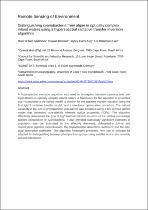 ResearchSpace
ResearchSpace
Distinguishing cyanobacteria from algae in optically complex inland waters using a hyperspectral radiative transfer inversion algorithm
JavaScript is disabled for your browser. Some features of this site may not work without it.
- ResearchSpace
- →
- Research Publications/Outputs
- →
- Journal Articles
- →
- View Item
| dc.contributor.author |
Matthews, MW

|
|
| dc.contributor.author |
Bernard, Stewart

|
|
| dc.contributor.author |
Evers-King, H

|
|
| dc.contributor.author |
Robertson Lain, L

|
|
| dc.date.accessioned | 2021-04-10T11:42:29Z | |
| dc.date.available | 2021-04-10T11:42:29Z | |
| dc.date.issued | 2020-10 | |
| dc.identifier.citation | Matthews, M., Bernard, S., Evers-King, H. & Robertson Lain, L. 2020. Distinguishing cyanobacteria from algae in optically complex inland waters using a hyperspectral radiative transfer inversion algorithm. <i>Remote Sensing of Environment, 248.</i> http://hdl.handle.net/10204/11972 | en_ZA |
| dc.identifier.issn | 0034-4257 | |
| dc.identifier.issn | 1879-0704 | |
| dc.identifier.uri | https://doi.org/10.1016/j.rse.2020.111981 | |
| dc.identifier.uri | https://www.sciencedirect.com/science/article/pii/S0034425720303515 | |
| dc.identifier.uri | http://hdl.handle.net/10204/11972 | |
| dc.description.abstract | A hyperspectral inversion algorithm was used to distinguish between cyanobacteria and algal blooms in optically complex inland waters. A framework for the algorithm is presented that incorporates a bio-optical model, a solution for the radiative transfer equation using the EcoLight-S radiative transfer model, and a non-linear optimization procedure. The natural variability in the size of phytoplankton populations was simulated using a two-layered sphere model that generated size-specific inherent optical properties (IOPs). The algorithm effectively determined the type of high-biomass blooms in terms of the relative percentage species composition of cyanobacteria. It also provided statistically significant estimates of population size (as estimated by the effective diameter), chlorophyll-a (chl-a) and phycocyanin pigment concentrations, the phytoplankton absorption coefficient, and the non-algal absorption coefficient. The algorithm framework presented here can in principle be adapted for distinguishing between phytoplankton groups using satellite and in situ remotely sensed reflectance. | en_US |
| dc.format | Abstract | en_US |
| dc.language.iso | en | en_US |
| dc.source | Remote Sensing of Environment, 248 | en_US |
| dc.subject | Algorithms | en_US |
| dc.subject | Bio-optics | en_US |
| dc.subject | Cyanobacteria | en_US |
| dc.subject | Harmful algal blooms | en_US |
| dc.subject | Hyperspectral | en_US |
| dc.subject | Remote sensing | en_US |
| dc.title | Distinguishing cyanobacteria from algae in optically complex inland waters using a hyperspectral radiative transfer inversion algorithm | en_US |
| dc.type | Article | en_US |
| dc.description.pages | 11pp | en_US |
| dc.description.note | © 2020 Elsevier Inc. All rights reserved. Due to copyright restrictions, the attached PDF file only contains the abstract of the full text item. For access to the full text item, please consult the publisher's website: https://www.sciencedirect.com/science/article/pii/S0034425720303515 | en_US |
| dc.description.cluster | Smart Places | en_US |
| dc.description.impactarea | en_US | |
| dc.identifier.apacitation | Matthews, M., Bernard, S., Evers-King, H., & Robertson Lain, L. (2020). Distinguishing cyanobacteria from algae in optically complex inland waters using a hyperspectral radiative transfer inversion algorithm. <i>Remote Sensing of Environment, 248</i>, http://hdl.handle.net/10204/11972 | en_ZA |
| dc.identifier.chicagocitation | Matthews, MW, Stewart Bernard, H Evers-King, and L Robertson Lain "Distinguishing cyanobacteria from algae in optically complex inland waters using a hyperspectral radiative transfer inversion algorithm." <i>Remote Sensing of Environment, 248</i> (2020) http://hdl.handle.net/10204/11972 | en_ZA |
| dc.identifier.vancouvercitation | Matthews M, Bernard S, Evers-King H, Robertson Lain L. Distinguishing cyanobacteria from algae in optically complex inland waters using a hyperspectral radiative transfer inversion algorithm. Remote Sensing of Environment, 248. 2020; http://hdl.handle.net/10204/11972. | en_ZA |
| dc.identifier.ris | TY - Article AU - Matthews, MW AU - Bernard, Stewart AU - Evers-King, H AU - Robertson Lain, L AB - A hyperspectral inversion algorithm was used to distinguish between cyanobacteria and algal blooms in optically complex inland waters. A framework for the algorithm is presented that incorporates a bio-optical model, a solution for the radiative transfer equation using the EcoLight-S radiative transfer model, and a non-linear optimization procedure. The natural variability in the size of phytoplankton populations was simulated using a two-layered sphere model that generated size-specific inherent optical properties (IOPs). The algorithm effectively determined the type of high-biomass blooms in terms of the relative percentage species composition of cyanobacteria. It also provided statistically significant estimates of population size (as estimated by the effective diameter), chlorophyll-a (chl-a) and phycocyanin pigment concentrations, the phytoplankton absorption coefficient, and the non-algal absorption coefficient. The algorithm framework presented here can in principle be adapted for distinguishing between phytoplankton groups using satellite and in situ remotely sensed reflectance. DA - 2020-10 DB - ResearchSpace DP - CSIR J1 - Remote Sensing of Environment, 248 KW - Algorithms KW - Bio-optics KW - Cyanobacteria KW - Harmful algal blooms KW - Hyperspectral KW - Remote sensing LK - https://researchspace.csir.co.za PY - 2020 SM - 0034-4257 SM - 1879-0704 T1 - Distinguishing cyanobacteria from algae in optically complex inland waters using a hyperspectral radiative transfer inversion algorithm TI - Distinguishing cyanobacteria from algae in optically complex inland waters using a hyperspectral radiative transfer inversion algorithm UR - http://hdl.handle.net/10204/11972 ER - | en_ZA |
| dc.identifier.worklist | 24227 | en_US |





